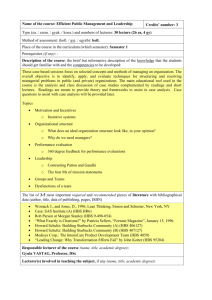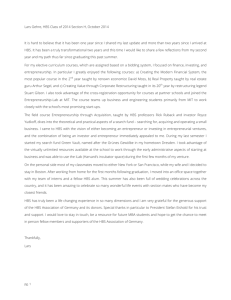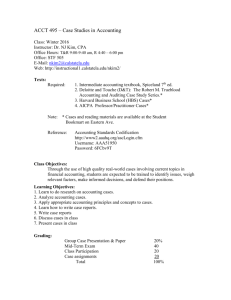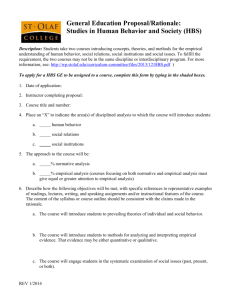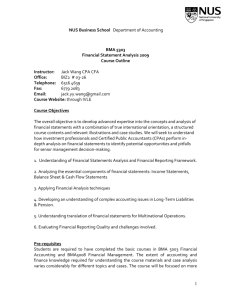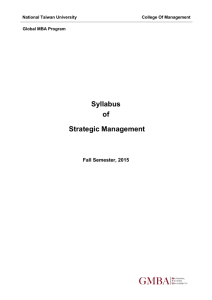MM,VK
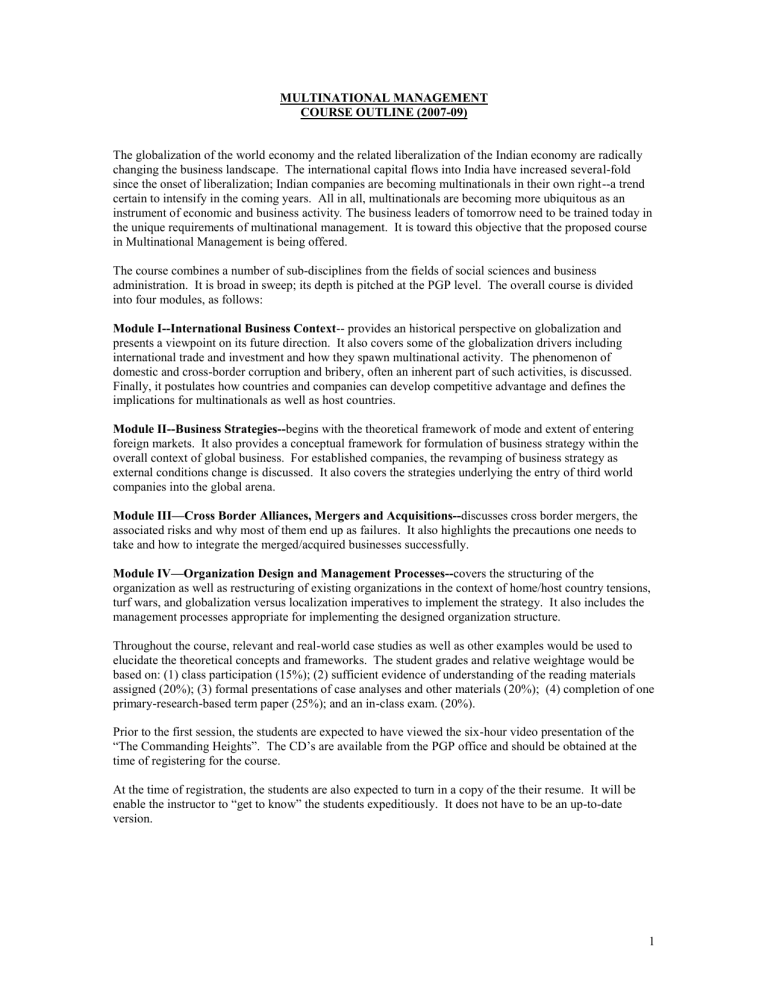
MULTINATIONAL MANAGEMENT
COURSE OUTLINE (2007-09)
The globalization of the world economy and the related liberalization of the Indian economy are radically changing the business landscape. The international capital flows into India have increased several-fold since the onset of liberalization; Indian companies are becoming multinationals in their own right--a trend certain to intensify in the coming years. All in all, multinationals are becoming more ubiquitous as an instrument of economic and business activity . The business leaders of tomorrow need to be trained today in the unique requirements of multinational management. It is toward this objective that the proposed course in Multinational Management is being offered.
The course combines a number of sub-disciplines from the fields of social sciences and business administration. It is broad in sweep; its depth is pitched at the PGP level. The overall course is divided into four modules, as follows:
Module I--International Business Context -- provides an historical perspective on globalization and presents a viewpoint on its future direction. It also covers some of the globalization drivers including international trade and investment and how they spawn multinational activity. The phenomenon of domestic and cross-border corruption and bribery, often an inherent part of such activities, is discussed.
Finally, it postulates how countries and companies can develop competitive advantage and defines the implications for multinationals as well as host countries.
Module II--Business Strategies-begins with the theoretical framework of mode and extent of entering foreign markets. It also provides a conceptual framework for formulation of business strategy within the overall context of global business. For established companies, the revamping of business strategy as external conditions change is discussed. It also covers the strategies underlying the entry of third world companies into the global arena.
Module III—Cross Border Alliances, Mergers and Acquisitions-discusses cross border mergers, the associated risks and why most of them end up as failures. It also highlights the precautions one needs to take and how to integrate the merged/acquired businesses successfully.
Module IV—Organization Design and Management Processes-covers the structuring of the organization as well as restructuring of existing organizations in the context of home/host country tensions, turf wars, and globalization versus localization imperatives to implement the strategy. It also includes the management processes appropriate for implementing the designed organization structure.
Throughout the course, relevant and real-world case studies as well as other examples would be used to elucidate the theoretical concepts and frameworks. The student grades and relative weightage would be based on: (1) class participation (15%); (2) sufficient evidence of understanding of the reading materials assigned (20%); (3) formal presentations of case analyses and other materials (20%); (4) completion of one primary-research-based term paper (25%); and an in-class exam. (20%).
Prior to the first session, the students are expected to have viewed the six-hour video presentation of the
“The Commanding Heights”. The CD’s are available from the PGP office and should be obtained at the time of registering for the course.
At the time of registration, the students are also expected to turn in a copy of the their resume. It will be enable the instructor to “get to know” the students expeditiously. It does not have to be an up-to-date version.
1
The outline of each session is as below:
1.
Introduction
- Class introduction
Review of course outline and learning objectives
Project teams formation
Other matters
Reading: Change and Challenge (Gerald M. Meier, The International Environment of
Business, 1998, Pp. 1-16, 24-29)
I. INTERNATIONAL BUSINESS CONTEXT
2. International Economic Integration—The Past and Present
Reading: Two Waves of Globalization: Superficial Similarities, Fundamental Differences.
(Richard E. Baldwin, Philippe Martin, NBER Working Paper 6904, January 1999, Pp. 1-33)
3. World Trade and Multinational Corporations (I)
- The Economic Gains from Trade: Comparative Advantage, HBS 9-796-183
Reading: Dynamic Comparative Advantage (Gerald M. Meier, The International Environment of Business, Pp. 33-55, 63-65)
Reading: Trade Policy (Gerald M. Meier, The International Environment of Business, Pp. 66-
91)
The World Trade Organization, HBS 9-703-015
4. The Politics and Economics of Foreign Direct Investment
Reading: International Capital Flows (Gerald M. Meier, The International Environment of
Business Pp. 133-150, 154-155, 158-163)
Reading: Private Foreign Investment in Developing Countries (Gerald M. Meier, The
International Environment of Business, Pp. 324-334
Reading: Note on Political Risk Analysis, HBS 9-798-022
Case: Enron Development Corporation: The Dabhol Power Project (A, B and C) HBS 9-596-
099, 100 and 101
2
5.
Dilemmas of Globalization
How Far will the International Economic Integration Go? (Dani Rodrik, Mimeo, 9/1/99 Pp. 1-
23)
Sinking Globalization: Niall Ferguson, Foreign Affairs, March-April 2005, Pp. 64-77.
- Reading: The Free Trade Fix (Tina Rosenburg, The New York Times, August 18, 2002)
6.
Corruption Within and Across Borders
Reading: Corruption as an International Policy Problem: Overview and Recommendations
(Kimberley Ann Elliott, Editor, Corruption and Global Economy, Pp. 175-229)
Bribery and Corruption, HBS 9-799-091
Caselets: Assessing Foreign Business Practices, HBS 9-796-105
Additional Caselets: Bribery and Extortion in International Business, HBS 9-700-055
7.
Comparative Advantage versus Competitive Advantage
Reading: Competitive Advantage of Nations (Michael E. Porter, Harvard Business Review,
March-April, 1990, Pp. 73-93)
Case: The Competitive Advantage of India, Stanford Graduate School of Business, Case IB-58.
Page no. to be determined
- Reading: Global Competition (Gerald M. Meier, The International Environment of Business,
Pp. 377-414)
II. BUSINESS STRATEGIES
8.
Sequence and Timing of Internationalization
Reading: The Product Life Cycle Hypothesis in a New International Environment (Raymond R.
Vernon, Oxford Bulletin of Economics and Statistics, November, 1979, Pp. 255-267)
Case: McDonald’s Conquers the World (Fortune, October 17, 1994 Pp. 103-116); A Really Big
Mac (Newsweek, November 17, 1997 Pp. 56-58); McDonald’s: Can it Regain its Golden Touch?
(Business Week, March 9, 1998, Pp. 70-77); Big Mac’s Makeover (The Economist, October 16,
2004 Pp. 63-65)
9.
Market Entry Strategy
- Reading: Designing Entry Strategies for International Markets (Franklin R. Root, Entry
Strategies for International Markets, New York, Lexington Books, 1990, Pp. 1-23)
Case: Mary Kay Cosmetics: Asian Market Entry, HBS 9-594-023
3
10. A Conceptual Framework of International Business Strategy (I)
Reading: Changing Pattern of International Competition, Michael E. Porter (David J. Teece, ed.,
The Competitive Challenge, Cambridge, 1987, Pp. 27-57)
Reading: Global Strategy……in a world of Nations ? George S. Yip, (Bartlett et. al. ed.:
Transnational Management, Irwin 2002, Pp. 297-311)
11. A Conceptual Framework of International Business Strategy (II)
Reading: All Strategy is Local (Bruce Greenwald and Judd Kahn, Harvard Business Review,
September 2005, Pp. 1-10) Check the page numbers from the library copy
Reading: Twenty Hubs and No HQ (C.K. Prahalad and Hrishi Bhattacharyya,
Strategy+Business, 05/29/08)
Case: General Electric Medical Systems, 2002 HBS 9-702-428
12. A Conceptual Framework of International Business Strategy (III)
Case Presentation in the Class: General Electric Medical Systems, 2002 HBS 9-702-428
13. Rethinking Global Strategy
Reading: Globalization Frustrated: The Case of White Goods (C.W.F. Baden-Fuller and John M.
Stopford, Strategic Management Journal, 12-7, 1991, Pp. 493-507)
Case: Whirlpool Corporation, HBS 9-391-037.
14. Empire Strikes Back
Reading: Lessons from Late Movers (Christopher A. Bartlett and Sumantra Ghosal, Harvard
Business Review, March-April, 2000, Pp. 132-142)
Reading: The 2008 BCG 100 New Global Challengers, Boston Consulting Group, Pp. 1-15.
Case: House of Tata: Acquiring a Global Footprint, HBS 9-708-446
III. CROSS-BORDER ALLIANCES, MERGERS AND ACQUISITIONS
15. Collaborative Strategies
Reading: Launching a World Class Joint Venture (James Bamford et. al. Harvard Business
Review, Februrary 2004, Pp. 1-10) Double check the page numbers from library copy
Case: Otis Elevator Company: China Strategy (A), HBS 9-396-098
4
16. Cross-Border Mergers and Acquisitions
Reading: The Dubious Logic of Global Megamergers (Pankaj Ghemawat and Fariborz Ghadar,
Harvard Business Review, July-August, 2000, Pp. 65-72)
Reading: Making the Deal Real: How GE Capital Integrates Acquisitions (Ronald N. Ashkens,
Lawrence J. DeMonaco, and Suzanne C. Francis, Harvard Business Review, Jan-Feb, 1998, Pp.
5-15)
Case: Ispat International N.V.: Spinning Steel into Gold, London Business School (1999)
IV. ORGANIZATION DESIGN AND MANAGEMENT PROCESSES
17 &18. The Organization of the Multinational Enterprise
- Reading: Derek Channon, Organizing for International Operations (Derek F. Channon,
Multinational Strategic Planning, New York: Amacom, 1978, Pp. 22-49)
- Reading: Building the Global Organization (Gorge S. Yip, Total Global Strategy, Pp 161-
196)
- Case: Corning Glass Works International (A), HBS 9-381-160 including class presentation.
19. Expanding Global Reach
- Tap Your Subsidiaries for Global Reach (Christopher Bartlett and Sumantra Ghosal, Harvard
Business Review, Nov.-Dec. 1986, Pp. 87-94)
- Case: P & G Japan: The SK-II Globalization Project, HBS 9-303-003
20. Parent/Subsidiary Tensions
Reading: Global Competitive Pressures and Host Country Demands: Managing Tensions in
Multinational Corporations (Yves L. Doz, Christopher A. Bartlett and C.K. Prahalad, California
Management Review, Spring 1981, Pp. 63-74)
Case: Philips versus Matsushita: A New Century, a New Round, HBS 9-302-049
21. Managing Across Cultures
Reading: What is a Global Manager (Christopher Bartlett and Sumantra Ghosal, Harvard
Business Review, August 2003, Pp. 1-10)
Silvio Napoli at Schindler India (A & B), HBS 9-303-086 and 9-302-054
GUEST LECTURES.
5


